Research on Key Figures in Computing Architecture Development
VerifiedAdded on 2020/04/07
|9
|3804
|71
Homework Assignment
AI Summary
This assignment presents a series of summaries on individuals who significantly influenced the development of modern computing. The first week focuses on John McCarthy, highlighting his contributions to artificial intelligence and the Lisp computer language, which paved the way for modern computer architecture. Week 2 examines Linus Torvalds and his pivotal role in developing the Linux operating system, emphasizing how a simple enhancement idea led to a new OS. The third week delves into the National Science Foundation Network (NSFNET) and its role as a precursor to the modern internet. Week 4 explores the Token Ring protocol as an alternative to Ethernet. Week 5 profiles the hacker Kevin Poulsen, discussing his hacking activities and his transformation. Finally, Week 6 examines the Web of Things, a future networking technology. Week 7 describes the history of Facebook, one of the most famous social media platforms. Each summary provides insights into the history and evolution of these technologies and their impact on society.
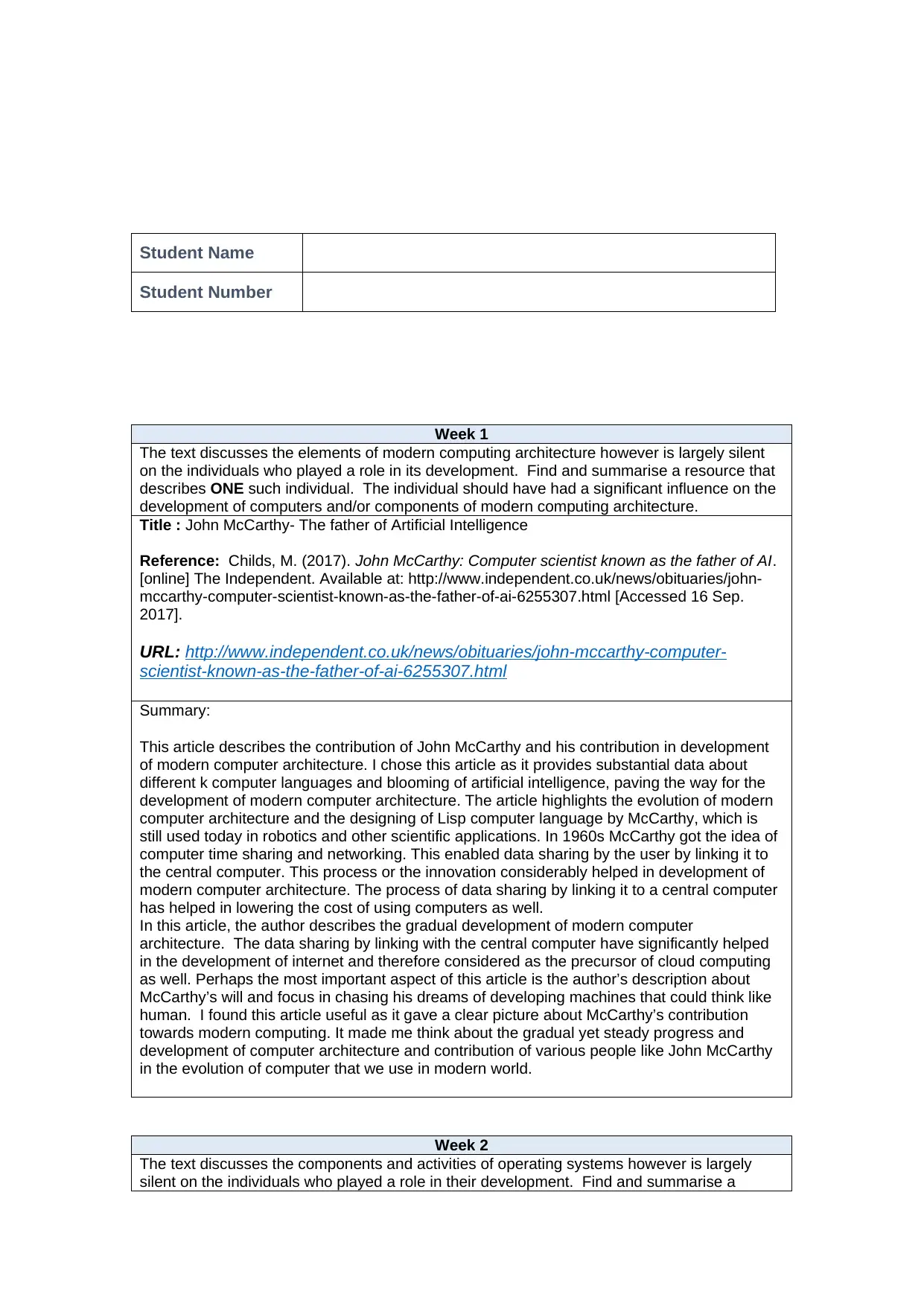
Student Name
Student Number
Week 1
The text discusses the elements of modern computing architecture however is largely silent
on the individuals who played a role in its development. Find and summarise a resource that
describes ONE such individual. The individual should have had a significant influence on the
development of computers and/or components of modern computing architecture.
Title : John McCarthy- The father of Artificial Intelligence
Reference: Childs, M. (2017). John McCarthy: Computer scientist known as the father of AI.
[online] The Independent. Available at: http://www.independent.co.uk/news/obituaries/john-
mccarthy-computer-scientist-known-as-the-father-of-ai-6255307.html [Accessed 16 Sep.
2017].
URL: http://www.independent.co.uk/news/obituaries/john-mccarthy-computer-
scientist-known-as-the-father-of-ai-6255307.html
Summary:
This article describes the contribution of John McCarthy and his contribution in development
of modern computer architecture. I chose this article as it provides substantial data about
different k computer languages and blooming of artificial intelligence, paving the way for the
development of modern computer architecture. The article highlights the evolution of modern
computer architecture and the designing of Lisp computer language by McCarthy, which is
still used today in robotics and other scientific applications. In 1960s McCarthy got the idea of
computer time sharing and networking. This enabled data sharing by the user by linking it to
the central computer. This process or the innovation considerably helped in development of
modern computer architecture. The process of data sharing by linking it to a central computer
has helped in lowering the cost of using computers as well.
In this article, the author describes the gradual development of modern computer
architecture. The data sharing by linking with the central computer have significantly helped
in the development of internet and therefore considered as the precursor of cloud computing
as well. Perhaps the most important aspect of this article is the author’s description about
McCarthy’s will and focus in chasing his dreams of developing machines that could think like
human. I found this article useful as it gave a clear picture about McCarthy’s contribution
towards modern computing. It made me think about the gradual yet steady progress and
development of computer architecture and contribution of various people like John McCarthy
in the evolution of computer that we use in modern world.
Week 2
The text discusses the components and activities of operating systems however is largely
silent on the individuals who played a role in their development. Find and summarise a
Student Number
Week 1
The text discusses the elements of modern computing architecture however is largely silent
on the individuals who played a role in its development. Find and summarise a resource that
describes ONE such individual. The individual should have had a significant influence on the
development of computers and/or components of modern computing architecture.
Title : John McCarthy- The father of Artificial Intelligence
Reference: Childs, M. (2017). John McCarthy: Computer scientist known as the father of AI.
[online] The Independent. Available at: http://www.independent.co.uk/news/obituaries/john-
mccarthy-computer-scientist-known-as-the-father-of-ai-6255307.html [Accessed 16 Sep.
2017].
URL: http://www.independent.co.uk/news/obituaries/john-mccarthy-computer-
scientist-known-as-the-father-of-ai-6255307.html
Summary:
This article describes the contribution of John McCarthy and his contribution in development
of modern computer architecture. I chose this article as it provides substantial data about
different k computer languages and blooming of artificial intelligence, paving the way for the
development of modern computer architecture. The article highlights the evolution of modern
computer architecture and the designing of Lisp computer language by McCarthy, which is
still used today in robotics and other scientific applications. In 1960s McCarthy got the idea of
computer time sharing and networking. This enabled data sharing by the user by linking it to
the central computer. This process or the innovation considerably helped in development of
modern computer architecture. The process of data sharing by linking it to a central computer
has helped in lowering the cost of using computers as well.
In this article, the author describes the gradual development of modern computer
architecture. The data sharing by linking with the central computer have significantly helped
in the development of internet and therefore considered as the precursor of cloud computing
as well. Perhaps the most important aspect of this article is the author’s description about
McCarthy’s will and focus in chasing his dreams of developing machines that could think like
human. I found this article useful as it gave a clear picture about McCarthy’s contribution
towards modern computing. It made me think about the gradual yet steady progress and
development of computer architecture and contribution of various people like John McCarthy
in the evolution of computer that we use in modern world.
Week 2
The text discusses the components and activities of operating systems however is largely
silent on the individuals who played a role in their development. Find and summarise a
Paraphrase This Document
Need a fresh take? Get an instant paraphrase of this document with our AI Paraphraser
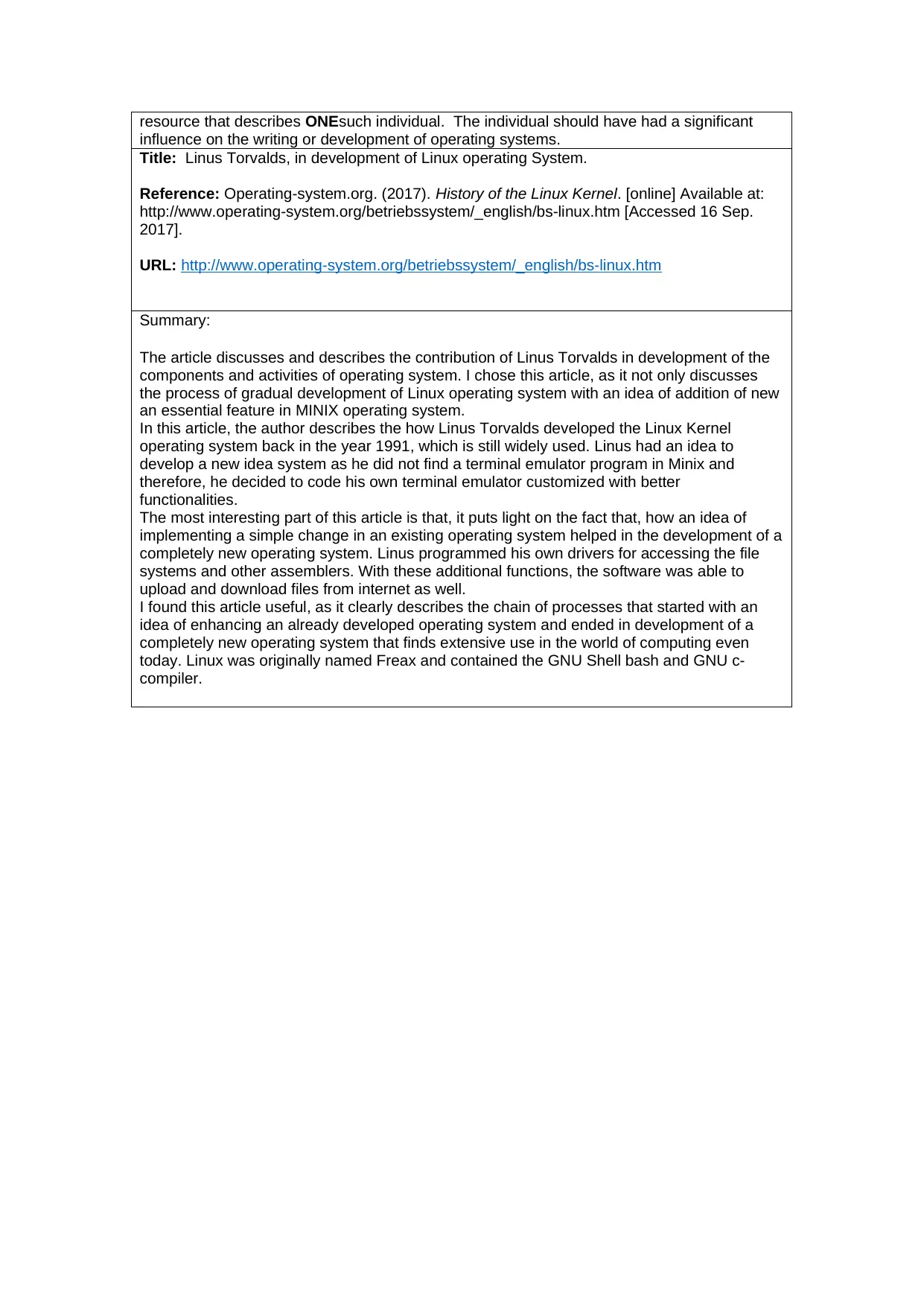
resource that describes ONEsuch individual. The individual should have had a significant
influence on the writing or development of operating systems.
Title: Linus Torvalds, in development of Linux operating System.
Reference: Operating-system.org. (2017). History of the Linux Kernel. [online] Available at:
http://www.operating-system.org/betriebssystem/_english/bs-linux.htm [Accessed 16 Sep.
2017].
URL: http://www.operating-system.org/betriebssystem/_english/bs-linux.htm
Summary:
The article discusses and describes the contribution of Linus Torvalds in development of the
components and activities of operating system. I chose this article, as it not only discusses
the process of gradual development of Linux operating system with an idea of addition of new
an essential feature in MINIX operating system.
In this article, the author describes the how Linus Torvalds developed the Linux Kernel
operating system back in the year 1991, which is still widely used. Linus had an idea to
develop a new idea system as he did not find a terminal emulator program in Minix and
therefore, he decided to code his own terminal emulator customized with better
functionalities.
The most interesting part of this article is that, it puts light on the fact that, how an idea of
implementing a simple change in an existing operating system helped in the development of a
completely new operating system. Linus programmed his own drivers for accessing the file
systems and other assemblers. With these additional functions, the software was able to
upload and download files from internet as well.
I found this article useful, as it clearly describes the chain of processes that started with an
idea of enhancing an already developed operating system and ended in development of a
completely new operating system that finds extensive use in the world of computing even
today. Linux was originally named Freax and contained the GNU Shell bash and GNU c-
compiler.
influence on the writing or development of operating systems.
Title: Linus Torvalds, in development of Linux operating System.
Reference: Operating-system.org. (2017). History of the Linux Kernel. [online] Available at:
http://www.operating-system.org/betriebssystem/_english/bs-linux.htm [Accessed 16 Sep.
2017].
URL: http://www.operating-system.org/betriebssystem/_english/bs-linux.htm
Summary:
The article discusses and describes the contribution of Linus Torvalds in development of the
components and activities of operating system. I chose this article, as it not only discusses
the process of gradual development of Linux operating system with an idea of addition of new
an essential feature in MINIX operating system.
In this article, the author describes the how Linus Torvalds developed the Linux Kernel
operating system back in the year 1991, which is still widely used. Linus had an idea to
develop a new idea system as he did not find a terminal emulator program in Minix and
therefore, he decided to code his own terminal emulator customized with better
functionalities.
The most interesting part of this article is that, it puts light on the fact that, how an idea of
implementing a simple change in an existing operating system helped in the development of a
completely new operating system. Linus programmed his own drivers for accessing the file
systems and other assemblers. With these additional functions, the software was able to
upload and download files from internet as well.
I found this article useful, as it clearly describes the chain of processes that started with an
idea of enhancing an already developed operating system and ended in development of a
completely new operating system that finds extensive use in the world of computing even
today. Linux was originally named Freax and contained the GNU Shell bash and GNU c-
compiler.
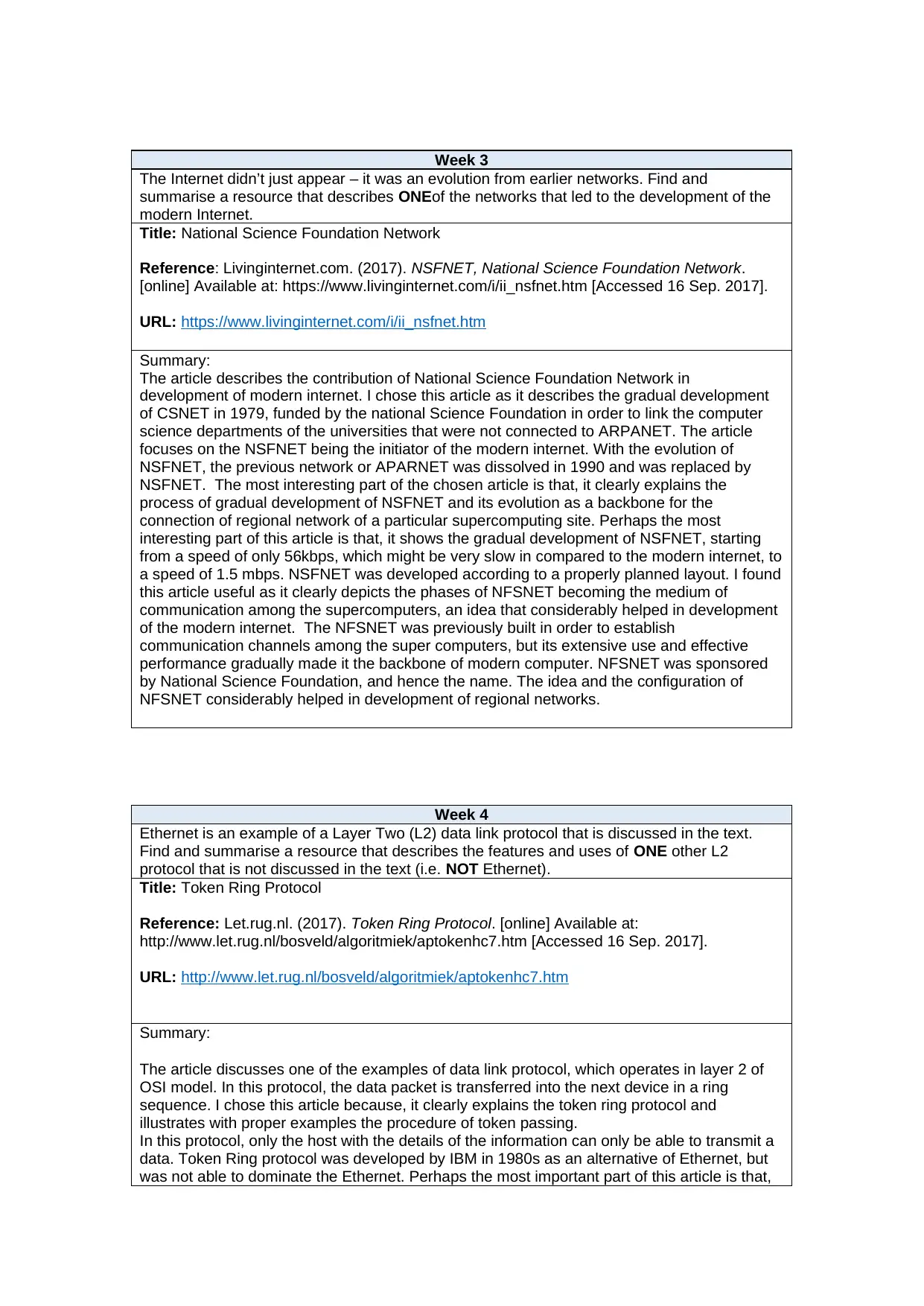
Week 3
The Internet didn’t just appear – it was an evolution from earlier networks. Find and
summarise a resource that describes ONEof the networks that led to the development of the
modern Internet.
Title: National Science Foundation Network
Reference: Livinginternet.com. (2017). NSFNET, National Science Foundation Network.
[online] Available at: https://www.livinginternet.com/i/ii_nsfnet.htm [Accessed 16 Sep. 2017].
URL: https://www.livinginternet.com/i/ii_nsfnet.htm
Summary:
The article describes the contribution of National Science Foundation Network in
development of modern internet. I chose this article as it describes the gradual development
of CSNET in 1979, funded by the national Science Foundation in order to link the computer
science departments of the universities that were not connected to ARPANET. The article
focuses on the NSFNET being the initiator of the modern internet. With the evolution of
NSFNET, the previous network or APARNET was dissolved in 1990 and was replaced by
NSFNET. The most interesting part of the chosen article is that, it clearly explains the
process of gradual development of NSFNET and its evolution as a backbone for the
connection of regional network of a particular supercomputing site. Perhaps the most
interesting part of this article is that, it shows the gradual development of NSFNET, starting
from a speed of only 56kbps, which might be very slow in compared to the modern internet, to
a speed of 1.5 mbps. NSFNET was developed according to a properly planned layout. I found
this article useful as it clearly depicts the phases of NFSNET becoming the medium of
communication among the supercomputers, an idea that considerably helped in development
of the modern internet. The NFSNET was previously built in order to establish
communication channels among the super computers, but its extensive use and effective
performance gradually made it the backbone of modern computer. NFSNET was sponsored
by National Science Foundation, and hence the name. The idea and the configuration of
NFSNET considerably helped in development of regional networks.
Week 4
Ethernet is an example of a Layer Two (L2) data link protocol that is discussed in the text.
Find and summarise a resource that describes the features and uses of ONE other L2
protocol that is not discussed in the text (i.e. NOT Ethernet).
Title: Token Ring Protocol
Reference: Let.rug.nl. (2017). Token Ring Protocol. [online] Available at:
http://www.let.rug.nl/bosveld/algoritmiek/aptokenhc7.htm [Accessed 16 Sep. 2017].
URL: http://www.let.rug.nl/bosveld/algoritmiek/aptokenhc7.htm
Summary:
The article discusses one of the examples of data link protocol, which operates in layer 2 of
OSI model. In this protocol, the data packet is transferred into the next device in a ring
sequence. I chose this article because, it clearly explains the token ring protocol and
illustrates with proper examples the procedure of token passing.
In this protocol, only the host with the details of the information can only be able to transmit a
data. Token Ring protocol was developed by IBM in 1980s as an alternative of Ethernet, but
was not able to dominate the Ethernet. Perhaps the most important part of this article is that,
The Internet didn’t just appear – it was an evolution from earlier networks. Find and
summarise a resource that describes ONEof the networks that led to the development of the
modern Internet.
Title: National Science Foundation Network
Reference: Livinginternet.com. (2017). NSFNET, National Science Foundation Network.
[online] Available at: https://www.livinginternet.com/i/ii_nsfnet.htm [Accessed 16 Sep. 2017].
URL: https://www.livinginternet.com/i/ii_nsfnet.htm
Summary:
The article describes the contribution of National Science Foundation Network in
development of modern internet. I chose this article as it describes the gradual development
of CSNET in 1979, funded by the national Science Foundation in order to link the computer
science departments of the universities that were not connected to ARPANET. The article
focuses on the NSFNET being the initiator of the modern internet. With the evolution of
NSFNET, the previous network or APARNET was dissolved in 1990 and was replaced by
NSFNET. The most interesting part of the chosen article is that, it clearly explains the
process of gradual development of NSFNET and its evolution as a backbone for the
connection of regional network of a particular supercomputing site. Perhaps the most
interesting part of this article is that, it shows the gradual development of NSFNET, starting
from a speed of only 56kbps, which might be very slow in compared to the modern internet, to
a speed of 1.5 mbps. NSFNET was developed according to a properly planned layout. I found
this article useful as it clearly depicts the phases of NFSNET becoming the medium of
communication among the supercomputers, an idea that considerably helped in development
of the modern internet. The NFSNET was previously built in order to establish
communication channels among the super computers, but its extensive use and effective
performance gradually made it the backbone of modern computer. NFSNET was sponsored
by National Science Foundation, and hence the name. The idea and the configuration of
NFSNET considerably helped in development of regional networks.
Week 4
Ethernet is an example of a Layer Two (L2) data link protocol that is discussed in the text.
Find and summarise a resource that describes the features and uses of ONE other L2
protocol that is not discussed in the text (i.e. NOT Ethernet).
Title: Token Ring Protocol
Reference: Let.rug.nl. (2017). Token Ring Protocol. [online] Available at:
http://www.let.rug.nl/bosveld/algoritmiek/aptokenhc7.htm [Accessed 16 Sep. 2017].
URL: http://www.let.rug.nl/bosveld/algoritmiek/aptokenhc7.htm
Summary:
The article discusses one of the examples of data link protocol, which operates in layer 2 of
OSI model. In this protocol, the data packet is transferred into the next device in a ring
sequence. I chose this article because, it clearly explains the token ring protocol and
illustrates with proper examples the procedure of token passing.
In this protocol, only the host with the details of the information can only be able to transmit a
data. Token Ring protocol was developed by IBM in 1980s as an alternative of Ethernet, but
was not able to dominate the Ethernet. Perhaps the most important part of this article is that,
⊘ This is a preview!⊘
Do you want full access?
Subscribe today to unlock all pages.

Trusted by 1+ million students worldwide
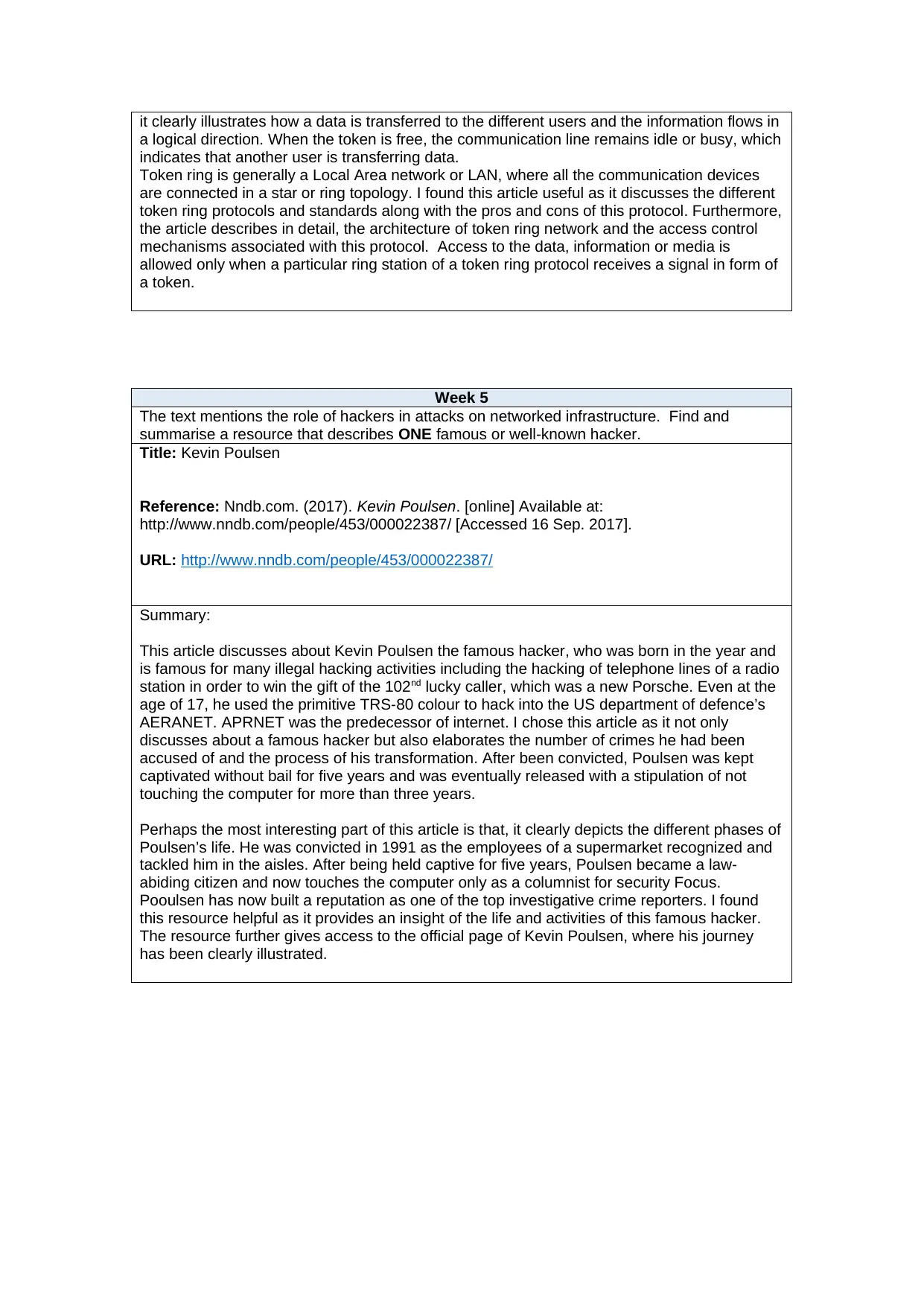
it clearly illustrates how a data is transferred to the different users and the information flows in
a logical direction. When the token is free, the communication line remains idle or busy, which
indicates that another user is transferring data.
Token ring is generally a Local Area network or LAN, where all the communication devices
are connected in a star or ring topology. I found this article useful as it discusses the different
token ring protocols and standards along with the pros and cons of this protocol. Furthermore,
the article describes in detail, the architecture of token ring network and the access control
mechanisms associated with this protocol. Access to the data, information or media is
allowed only when a particular ring station of a token ring protocol receives a signal in form of
a token.
Week 5
The text mentions the role of hackers in attacks on networked infrastructure. Find and
summarise a resource that describes ONE famous or well-known hacker.
Title: Kevin Poulsen
Reference: Nndb.com. (2017). Kevin Poulsen. [online] Available at:
http://www.nndb.com/people/453/000022387/ [Accessed 16 Sep. 2017].
URL: http://www.nndb.com/people/453/000022387/
Summary:
This article discusses about Kevin Poulsen the famous hacker, who was born in the year and
is famous for many illegal hacking activities including the hacking of telephone lines of a radio
station in order to win the gift of the 102nd lucky caller, which was a new Porsche. Even at the
age of 17, he used the primitive TRS-80 colour to hack into the US department of defence’s
AERANET. APRNET was the predecessor of internet. I chose this article as it not only
discusses about a famous hacker but also elaborates the number of crimes he had been
accused of and the process of his transformation. After been convicted, Poulsen was kept
captivated without bail for five years and was eventually released with a stipulation of not
touching the computer for more than three years.
Perhaps the most interesting part of this article is that, it clearly depicts the different phases of
Poulsen’s life. He was convicted in 1991 as the employees of a supermarket recognized and
tackled him in the aisles. After being held captive for five years, Poulsen became a law-
abiding citizen and now touches the computer only as a columnist for security Focus.
Pooulsen has now built a reputation as one of the top investigative crime reporters. I found
this resource helpful as it provides an insight of the life and activities of this famous hacker.
The resource further gives access to the official page of Kevin Poulsen, where his journey
has been clearly illustrated.
a logical direction. When the token is free, the communication line remains idle or busy, which
indicates that another user is transferring data.
Token ring is generally a Local Area network or LAN, where all the communication devices
are connected in a star or ring topology. I found this article useful as it discusses the different
token ring protocols and standards along with the pros and cons of this protocol. Furthermore,
the article describes in detail, the architecture of token ring network and the access control
mechanisms associated with this protocol. Access to the data, information or media is
allowed only when a particular ring station of a token ring protocol receives a signal in form of
a token.
Week 5
The text mentions the role of hackers in attacks on networked infrastructure. Find and
summarise a resource that describes ONE famous or well-known hacker.
Title: Kevin Poulsen
Reference: Nndb.com. (2017). Kevin Poulsen. [online] Available at:
http://www.nndb.com/people/453/000022387/ [Accessed 16 Sep. 2017].
URL: http://www.nndb.com/people/453/000022387/
Summary:
This article discusses about Kevin Poulsen the famous hacker, who was born in the year and
is famous for many illegal hacking activities including the hacking of telephone lines of a radio
station in order to win the gift of the 102nd lucky caller, which was a new Porsche. Even at the
age of 17, he used the primitive TRS-80 colour to hack into the US department of defence’s
AERANET. APRNET was the predecessor of internet. I chose this article as it not only
discusses about a famous hacker but also elaborates the number of crimes he had been
accused of and the process of his transformation. After been convicted, Poulsen was kept
captivated without bail for five years and was eventually released with a stipulation of not
touching the computer for more than three years.
Perhaps the most interesting part of this article is that, it clearly depicts the different phases of
Poulsen’s life. He was convicted in 1991 as the employees of a supermarket recognized and
tackled him in the aisles. After being held captive for five years, Poulsen became a law-
abiding citizen and now touches the computer only as a columnist for security Focus.
Pooulsen has now built a reputation as one of the top investigative crime reporters. I found
this resource helpful as it provides an insight of the life and activities of this famous hacker.
The resource further gives access to the official page of Kevin Poulsen, where his journey
has been clearly illustrated.
Paraphrase This Document
Need a fresh take? Get an instant paraphrase of this document with our AI Paraphraser
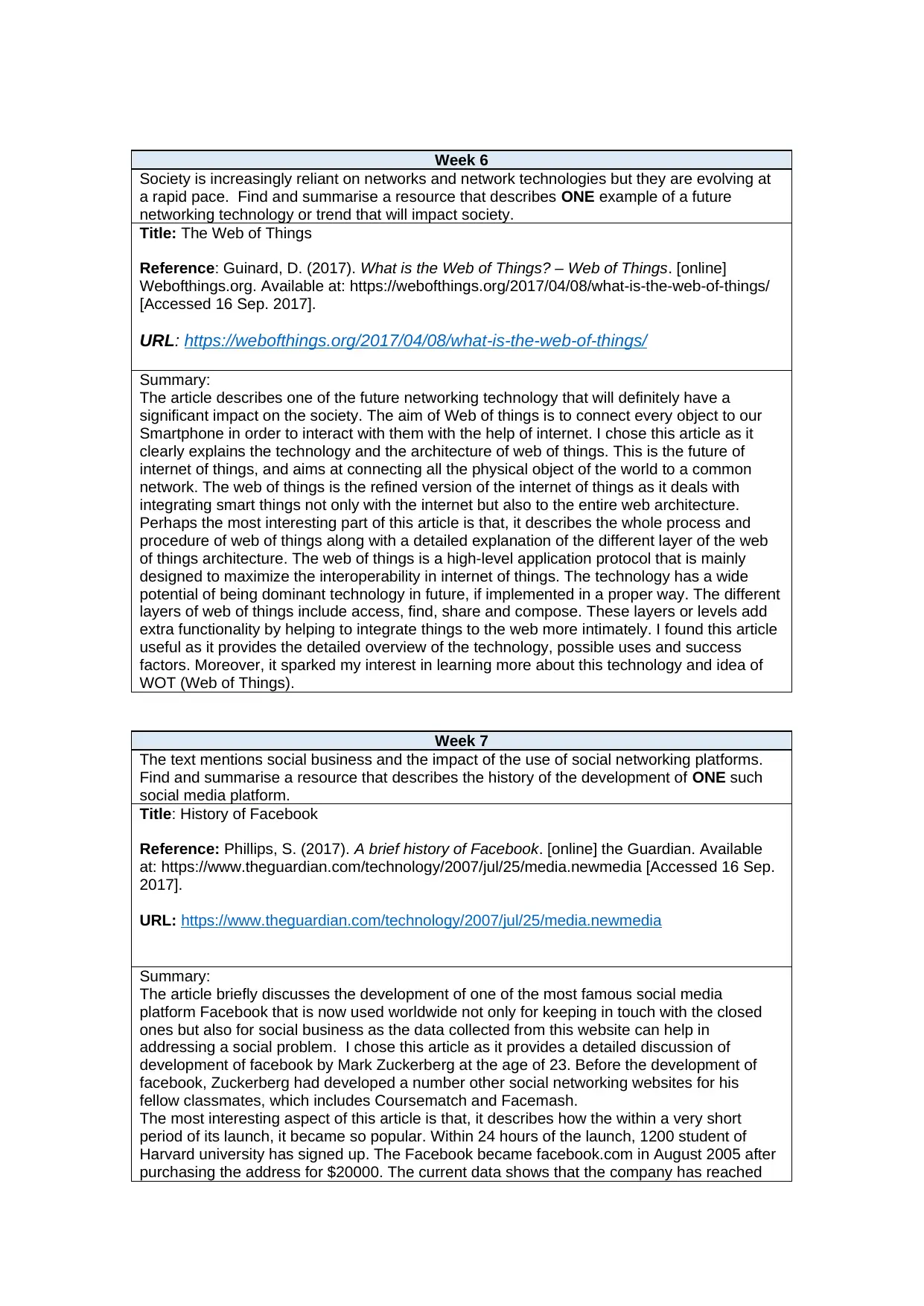
Week 6
Society is increasingly reliant on networks and network technologies but they are evolving at
a rapid pace. Find and summarise a resource that describes ONE example of a future
networking technology or trend that will impact society.
Title: The Web of Things
Reference: Guinard, D. (2017). What is the Web of Things? – Web of Things. [online]
Webofthings.org. Available at: https://webofthings.org/2017/04/08/what-is-the-web-of-things/
[Accessed 16 Sep. 2017].
URL: https://webofthings.org/2017/04/08/what-is-the-web-of-things/
Summary:
The article describes one of the future networking technology that will definitely have a
significant impact on the society. The aim of Web of things is to connect every object to our
Smartphone in order to interact with them with the help of internet. I chose this article as it
clearly explains the technology and the architecture of web of things. This is the future of
internet of things, and aims at connecting all the physical object of the world to a common
network. The web of things is the refined version of the internet of things as it deals with
integrating smart things not only with the internet but also to the entire web architecture.
Perhaps the most interesting part of this article is that, it describes the whole process and
procedure of web of things along with a detailed explanation of the different layer of the web
of things architecture. The web of things is a high-level application protocol that is mainly
designed to maximize the interoperability in internet of things. The technology has a wide
potential of being dominant technology in future, if implemented in a proper way. The different
layers of web of things include access, find, share and compose. These layers or levels add
extra functionality by helping to integrate things to the web more intimately. I found this article
useful as it provides the detailed overview of the technology, possible uses and success
factors. Moreover, it sparked my interest in learning more about this technology and idea of
WOT (Web of Things).
Week 7
The text mentions social business and the impact of the use of social networking platforms.
Find and summarise a resource that describes the history of the development of ONE such
social media platform.
Title: History of Facebook
Reference: Phillips, S. (2017). A brief history of Facebook. [online] the Guardian. Available
at: https://www.theguardian.com/technology/2007/jul/25/media.newmedia [Accessed 16 Sep.
2017].
URL: https://www.theguardian.com/technology/2007/jul/25/media.newmedia
Summary:
The article briefly discusses the development of one of the most famous social media
platform Facebook that is now used worldwide not only for keeping in touch with the closed
ones but also for social business as the data collected from this website can help in
addressing a social problem. I chose this article as it provides a detailed discussion of
development of facebook by Mark Zuckerberg at the age of 23. Before the development of
facebook, Zuckerberg had developed a number other social networking websites for his
fellow classmates, which includes Coursematch and Facemash.
The most interesting aspect of this article is that, it describes how the within a very short
period of its launch, it became so popular. Within 24 hours of the launch, 1200 student of
Harvard university has signed up. The Facebook became facebook.com in August 2005 after
purchasing the address for $20000. The current data shows that the company has reached
Society is increasingly reliant on networks and network technologies but they are evolving at
a rapid pace. Find and summarise a resource that describes ONE example of a future
networking technology or trend that will impact society.
Title: The Web of Things
Reference: Guinard, D. (2017). What is the Web of Things? – Web of Things. [online]
Webofthings.org. Available at: https://webofthings.org/2017/04/08/what-is-the-web-of-things/
[Accessed 16 Sep. 2017].
URL: https://webofthings.org/2017/04/08/what-is-the-web-of-things/
Summary:
The article describes one of the future networking technology that will definitely have a
significant impact on the society. The aim of Web of things is to connect every object to our
Smartphone in order to interact with them with the help of internet. I chose this article as it
clearly explains the technology and the architecture of web of things. This is the future of
internet of things, and aims at connecting all the physical object of the world to a common
network. The web of things is the refined version of the internet of things as it deals with
integrating smart things not only with the internet but also to the entire web architecture.
Perhaps the most interesting part of this article is that, it describes the whole process and
procedure of web of things along with a detailed explanation of the different layer of the web
of things architecture. The web of things is a high-level application protocol that is mainly
designed to maximize the interoperability in internet of things. The technology has a wide
potential of being dominant technology in future, if implemented in a proper way. The different
layers of web of things include access, find, share and compose. These layers or levels add
extra functionality by helping to integrate things to the web more intimately. I found this article
useful as it provides the detailed overview of the technology, possible uses and success
factors. Moreover, it sparked my interest in learning more about this technology and idea of
WOT (Web of Things).
Week 7
The text mentions social business and the impact of the use of social networking platforms.
Find and summarise a resource that describes the history of the development of ONE such
social media platform.
Title: History of Facebook
Reference: Phillips, S. (2017). A brief history of Facebook. [online] the Guardian. Available
at: https://www.theguardian.com/technology/2007/jul/25/media.newmedia [Accessed 16 Sep.
2017].
URL: https://www.theguardian.com/technology/2007/jul/25/media.newmedia
Summary:
The article briefly discusses the development of one of the most famous social media
platform Facebook that is now used worldwide not only for keeping in touch with the closed
ones but also for social business as the data collected from this website can help in
addressing a social problem. I chose this article as it provides a detailed discussion of
development of facebook by Mark Zuckerberg at the age of 23. Before the development of
facebook, Zuckerberg had developed a number other social networking websites for his
fellow classmates, which includes Coursematch and Facemash.
The most interesting aspect of this article is that, it describes how the within a very short
period of its launch, it became so popular. Within 24 hours of the launch, 1200 student of
Harvard university has signed up. The Facebook became facebook.com in August 2005 after
purchasing the address for $20000. The current data shows that the company has reached

30 million registered users worldwide thus making it the largest social networking site.
I found this article useful as it helped elaborated the gradual development and spreading of
this website. The primary reason of this website being so popular is because, it does not
charge anything from the user and signing into the website is completely free. The website
have gradually developed over the years and now enables people to sends gifts to the
friends, post advertisements and so on. Anyone with a valid email id or a phone number can
access and use Facebook.
Week 8
With the advent of mass data collection and storage has come data mining. Find and
summarise a resource that describes ONE example where data mining has been used
successfully by a business. You should not use any examples covered in the textbook.
Title: Netflix in Data mining
Reference: Anon, (2017). How Netflix Uses Analytics To Select Movies, Create Content, &
Make Multimillion Dollar Decisions. [online] Available at: https://blog.kissmetrics.com/how-
netflix-uses-analytics/ [Accessed 16 Sep. 2017].
URL: https://blog.kissmetrics.com/how-netflix-uses-analytics/
Summary:
This article describes how the process of big data and data miming can be successfully used
in a business, Netflix being the example of one such business. Netflix is one of the most
popular internet television streaming services over the world and is spread over 130 new
counties. I chose this article as the author of the article clearly depicts the use of data mining
in business of Netflix. The business of Netflix is mainly data driven and data mining is very
important in determining the likes and dislikes of the people.
The most important aspect of this article is that, the author describes the process by which
Netflix uses data mining to scan through millions of data in order to have an idea about the
preferences of its users. Netflix has approximately 103.95 million users worldwide and
knowing about the preferences of different people would have been difficult without the
process of data mining. Therefore, data mining considerably helps in managing the business
of Netflix. The process of data collection is done by Netflix by tracking certain events, which
includes the pause, rewind and fast forward data, the content users are watching an on what
day, the time of watching, the ratings given, the searches, browsing history and so on. I found
this article useful as it gives a clear view of the business strategy of Netflix, which helps in
determining the success point of the business. The data mining process used by Netflix
includes a well defined algorithm, which makes the searching procedure even more easier.
I found this article useful as it helped elaborated the gradual development and spreading of
this website. The primary reason of this website being so popular is because, it does not
charge anything from the user and signing into the website is completely free. The website
have gradually developed over the years and now enables people to sends gifts to the
friends, post advertisements and so on. Anyone with a valid email id or a phone number can
access and use Facebook.
Week 8
With the advent of mass data collection and storage has come data mining. Find and
summarise a resource that describes ONE example where data mining has been used
successfully by a business. You should not use any examples covered in the textbook.
Title: Netflix in Data mining
Reference: Anon, (2017). How Netflix Uses Analytics To Select Movies, Create Content, &
Make Multimillion Dollar Decisions. [online] Available at: https://blog.kissmetrics.com/how-
netflix-uses-analytics/ [Accessed 16 Sep. 2017].
URL: https://blog.kissmetrics.com/how-netflix-uses-analytics/
Summary:
This article describes how the process of big data and data miming can be successfully used
in a business, Netflix being the example of one such business. Netflix is one of the most
popular internet television streaming services over the world and is spread over 130 new
counties. I chose this article as the author of the article clearly depicts the use of data mining
in business of Netflix. The business of Netflix is mainly data driven and data mining is very
important in determining the likes and dislikes of the people.
The most important aspect of this article is that, the author describes the process by which
Netflix uses data mining to scan through millions of data in order to have an idea about the
preferences of its users. Netflix has approximately 103.95 million users worldwide and
knowing about the preferences of different people would have been difficult without the
process of data mining. Therefore, data mining considerably helps in managing the business
of Netflix. The process of data collection is done by Netflix by tracking certain events, which
includes the pause, rewind and fast forward data, the content users are watching an on what
day, the time of watching, the ratings given, the searches, browsing history and so on. I found
this article useful as it gives a clear view of the business strategy of Netflix, which helps in
determining the success point of the business. The data mining process used by Netflix
includes a well defined algorithm, which makes the searching procedure even more easier.
⊘ This is a preview!⊘
Do you want full access?
Subscribe today to unlock all pages.

Trusted by 1+ million students worldwide
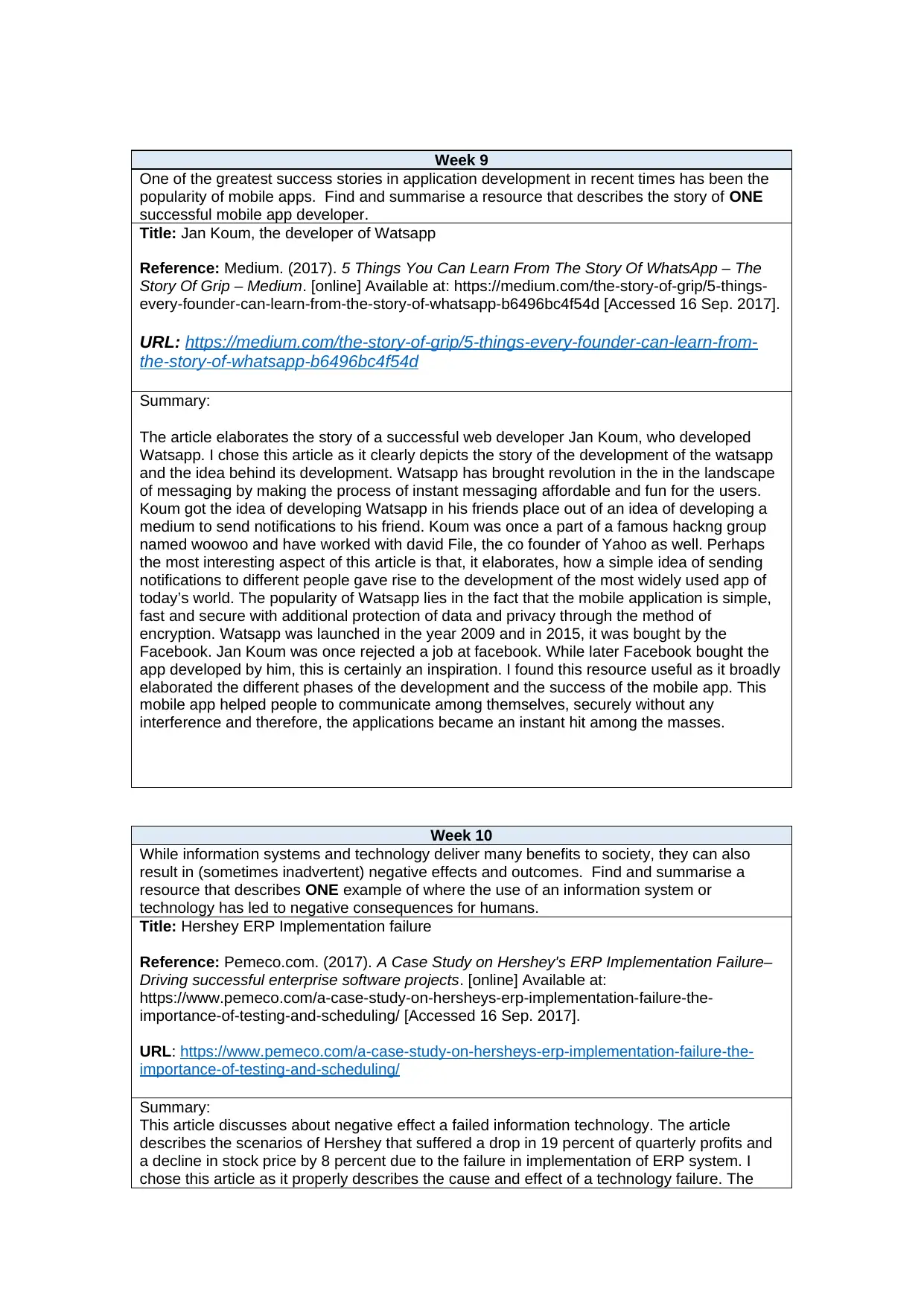
Week 9
One of the greatest success stories in application development in recent times has been the
popularity of mobile apps. Find and summarise a resource that describes the story of ONE
successful mobile app developer.
Title: Jan Koum, the developer of Watsapp
Reference: Medium. (2017). 5 Things You Can Learn From The Story Of WhatsApp – The
Story Of Grip – Medium. [online] Available at: https://medium.com/the-story-of-grip/5-things-
every-founder-can-learn-from-the-story-of-whatsapp-b6496bc4f54d [Accessed 16 Sep. 2017].
URL: https://medium.com/the-story-of-grip/5-things-every-founder-can-learn-from-
the-story-of-whatsapp-b6496bc4f54d
Summary:
The article elaborates the story of a successful web developer Jan Koum, who developed
Watsapp. I chose this article as it clearly depicts the story of the development of the watsapp
and the idea behind its development. Watsapp has brought revolution in the in the landscape
of messaging by making the process of instant messaging affordable and fun for the users.
Koum got the idea of developing Watsapp in his friends place out of an idea of developing a
medium to send notifications to his friend. Koum was once a part of a famous hackng group
named woowoo and have worked with david File, the co founder of Yahoo as well. Perhaps
the most interesting aspect of this article is that, it elaborates, how a simple idea of sending
notifications to different people gave rise to the development of the most widely used app of
today’s world. The popularity of Watsapp lies in the fact that the mobile application is simple,
fast and secure with additional protection of data and privacy through the method of
encryption. Watsapp was launched in the year 2009 and in 2015, it was bought by the
Facebook. Jan Koum was once rejected a job at facebook. While later Facebook bought the
app developed by him, this is certainly an inspiration. I found this resource useful as it broadly
elaborated the different phases of the development and the success of the mobile app. This
mobile app helped people to communicate among themselves, securely without any
interference and therefore, the applications became an instant hit among the masses.
Week 10
While information systems and technology deliver many benefits to society, they can also
result in (sometimes inadvertent) negative effects and outcomes. Find and summarise a
resource that describes ONE example of where the use of an information system or
technology has led to negative consequences for humans.
Title: Hershey ERP Implementation failure
Reference: Pemeco.com. (2017). A Case Study on Hershey's ERP Implementation Failure–
Driving successful enterprise software projects. [online] Available at:
https://www.pemeco.com/a-case-study-on-hersheys-erp-implementation-failure-the-
importance-of-testing-and-scheduling/ [Accessed 16 Sep. 2017].
URL: https://www.pemeco.com/a-case-study-on-hersheys-erp-implementation-failure-the-
importance-of-testing-and-scheduling/
Summary:
This article discusses about negative effect a failed information technology. The article
describes the scenarios of Hershey that suffered a drop in 19 percent of quarterly profits and
a decline in stock price by 8 percent due to the failure in implementation of ERP system. I
chose this article as it properly describes the cause and effect of a technology failure. The
One of the greatest success stories in application development in recent times has been the
popularity of mobile apps. Find and summarise a resource that describes the story of ONE
successful mobile app developer.
Title: Jan Koum, the developer of Watsapp
Reference: Medium. (2017). 5 Things You Can Learn From The Story Of WhatsApp – The
Story Of Grip – Medium. [online] Available at: https://medium.com/the-story-of-grip/5-things-
every-founder-can-learn-from-the-story-of-whatsapp-b6496bc4f54d [Accessed 16 Sep. 2017].
URL: https://medium.com/the-story-of-grip/5-things-every-founder-can-learn-from-
the-story-of-whatsapp-b6496bc4f54d
Summary:
The article elaborates the story of a successful web developer Jan Koum, who developed
Watsapp. I chose this article as it clearly depicts the story of the development of the watsapp
and the idea behind its development. Watsapp has brought revolution in the in the landscape
of messaging by making the process of instant messaging affordable and fun for the users.
Koum got the idea of developing Watsapp in his friends place out of an idea of developing a
medium to send notifications to his friend. Koum was once a part of a famous hackng group
named woowoo and have worked with david File, the co founder of Yahoo as well. Perhaps
the most interesting aspect of this article is that, it elaborates, how a simple idea of sending
notifications to different people gave rise to the development of the most widely used app of
today’s world. The popularity of Watsapp lies in the fact that the mobile application is simple,
fast and secure with additional protection of data and privacy through the method of
encryption. Watsapp was launched in the year 2009 and in 2015, it was bought by the
Facebook. Jan Koum was once rejected a job at facebook. While later Facebook bought the
app developed by him, this is certainly an inspiration. I found this resource useful as it broadly
elaborated the different phases of the development and the success of the mobile app. This
mobile app helped people to communicate among themselves, securely without any
interference and therefore, the applications became an instant hit among the masses.
Week 10
While information systems and technology deliver many benefits to society, they can also
result in (sometimes inadvertent) negative effects and outcomes. Find and summarise a
resource that describes ONE example of where the use of an information system or
technology has led to negative consequences for humans.
Title: Hershey ERP Implementation failure
Reference: Pemeco.com. (2017). A Case Study on Hershey's ERP Implementation Failure–
Driving successful enterprise software projects. [online] Available at:
https://www.pemeco.com/a-case-study-on-hersheys-erp-implementation-failure-the-
importance-of-testing-and-scheduling/ [Accessed 16 Sep. 2017].
URL: https://www.pemeco.com/a-case-study-on-hersheys-erp-implementation-failure-the-
importance-of-testing-and-scheduling/
Summary:
This article discusses about negative effect a failed information technology. The article
describes the scenarios of Hershey that suffered a drop in 19 percent of quarterly profits and
a decline in stock price by 8 percent due to the failure in implementation of ERP system. I
chose this article as it properly describes the cause and effect of a technology failure. The
Paraphrase This Document
Need a fresh take? Get an instant paraphrase of this document with our AI Paraphraser

major reason of failure of ERP was that, Hershey tried to implement the development and the
launching phase of the software in much constricted time. Hershey tried to implement the new
software during the busiest period of their business and this was the main reason of a loss in
huge amount.
Perhaps the most interesting aspect of this article is that it broadly describes the different
phases of the implementation of IT system in a leading company and the reason of the failure
and considerable loss. The failure of IT implementation and the significant loss was however
the reason of improper planning and implementation of the software. The failure and loss
were significant because Hershey had set out to upgrade the patchwork of its IT system
during the busiest period of their business and on top of that, it sacrificed the testing phase in
order to reduce the cost and time of implementation. The improper implementation of ERP
had resulted in failure of fulfilment of orders worth of $100, thus resulting in a huge loss. I
found this article useful as it highlighted the need of proper implementation of any software
and the negative impact it can led upon human or in an organization.
launching phase of the software in much constricted time. Hershey tried to implement the new
software during the busiest period of their business and this was the main reason of a loss in
huge amount.
Perhaps the most interesting aspect of this article is that it broadly describes the different
phases of the implementation of IT system in a leading company and the reason of the failure
and considerable loss. The failure of IT implementation and the significant loss was however
the reason of improper planning and implementation of the software. The failure and loss
were significant because Hershey had set out to upgrade the patchwork of its IT system
during the busiest period of their business and on top of that, it sacrificed the testing phase in
order to reduce the cost and time of implementation. The improper implementation of ERP
had resulted in failure of fulfilment of orders worth of $100, thus resulting in a huge loss. I
found this article useful as it highlighted the need of proper implementation of any software
and the negative impact it can led upon human or in an organization.
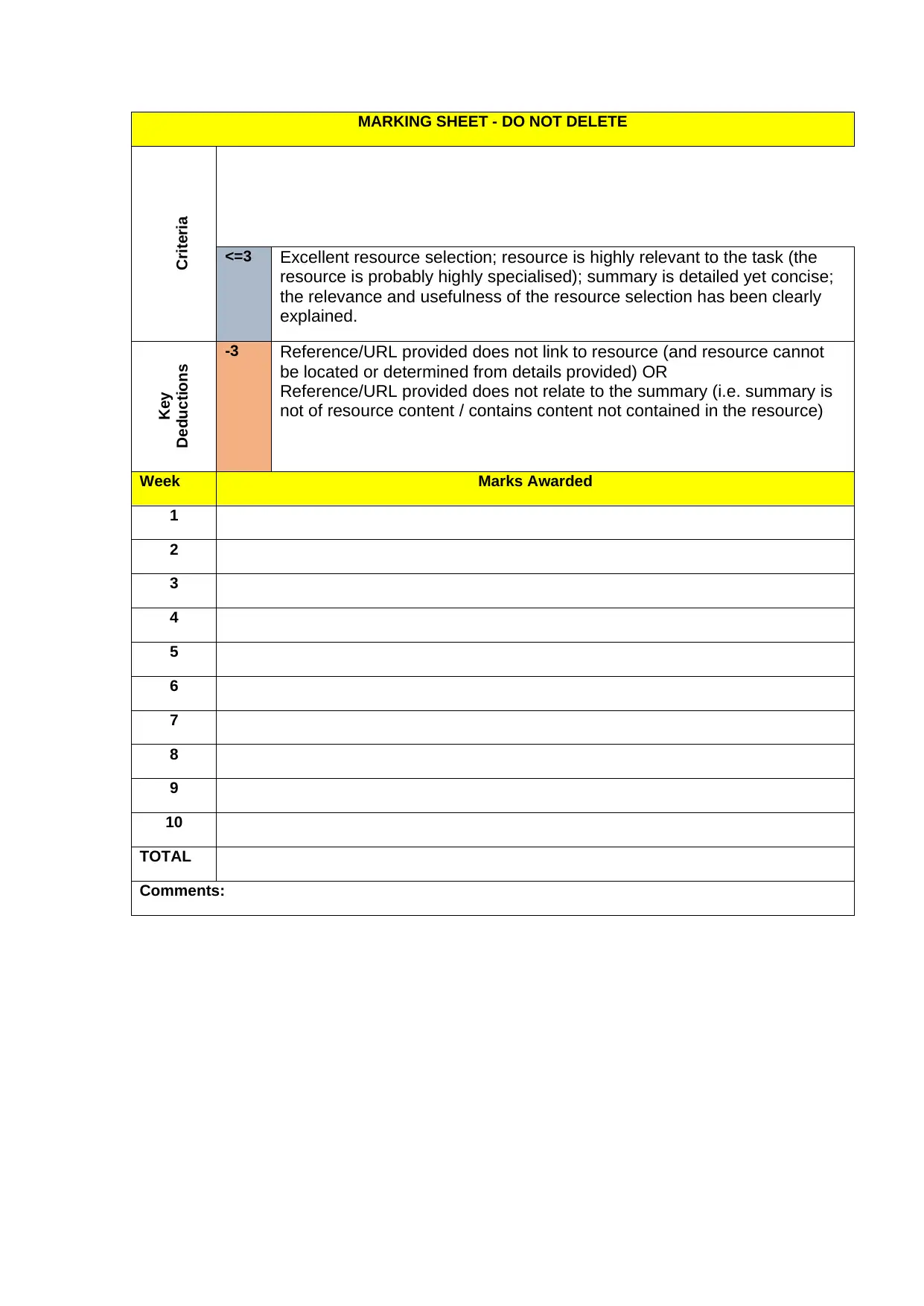
MARKING SHEET - DO NOT DELETE
Criteria
<=3 Excellent resource selection; resource is highly relevant to the task (the
resource is probably highly specialised); summary is detailed yet concise;
the relevance and usefulness of the resource selection has been clearly
explained.
Key
Deductions -3 Reference/URL provided does not link to resource (and resource cannot
be located or determined from details provided) OR
Reference/URL provided does not relate to the summary (i.e. summary is
not of resource content / contains content not contained in the resource)
Week Marks Awarded
1
2
3
4
5
6
7
8
9
10
TOTAL
Comments:
Criteria
<=3 Excellent resource selection; resource is highly relevant to the task (the
resource is probably highly specialised); summary is detailed yet concise;
the relevance and usefulness of the resource selection has been clearly
explained.
Key
Deductions -3 Reference/URL provided does not link to resource (and resource cannot
be located or determined from details provided) OR
Reference/URL provided does not relate to the summary (i.e. summary is
not of resource content / contains content not contained in the resource)
Week Marks Awarded
1
2
3
4
5
6
7
8
9
10
TOTAL
Comments:
⊘ This is a preview!⊘
Do you want full access?
Subscribe today to unlock all pages.

Trusted by 1+ million students worldwide
1 out of 9
Related Documents
Your All-in-One AI-Powered Toolkit for Academic Success.
+13062052269
info@desklib.com
Available 24*7 on WhatsApp / Email
![[object Object]](/_next/static/media/star-bottom.7253800d.svg)
Unlock your academic potential
Copyright © 2020–2025 A2Z Services. All Rights Reserved. Developed and managed by ZUCOL.





